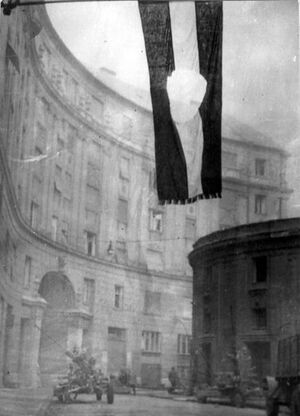Lyonheimerish Communist Revolution
| Lyonheimerish Communist Revolution | |||||||
|---|---|---|---|---|---|---|---|
| Part of Era of Civil Wars | |||||||
 The flag of the Lyonheimer Soviet Republic with the communist seal cut out | |||||||
| |||||||
| Belligerents | |||||||
|
|
| ||||||
| Commanders and leaders | |||||||
|
|
| ||||||
| Casualties and losses | |||||||
| 452 Killed | Unknown | ||||||
The Lyonheimerish Communist Revolution (Hungarian: 1950-es forradalmak) otherwise known as the Lyonheimer Uprising was a nationwide conflict that was started by civilians in protest of communist rule. Lead by soon to be Prime-Minister Imre Nagy, the movement gained enough traction to start a riot which resulted in the downfall of the Lyonheimer Soviet Republic. The Soviet Republic, lead by Milkos Varmaskov, used military power to try to hold off the rebellions, however they were too far spread for them to be effective.
Conflict Escalation
In July 1954, Imre Nagy, a democratic politician, began a movement for a change in the governmental system in Lyonheimer, as felt citizens were mistreated under communist rule. Many of the citizens in the smaller towns and cities felt strongly in the same mindest, as they had been mistreated by the Soviet Party lead by Milkos Varmaskov.
The movement gained serious attraction, as Nagy made a speech on the 8th of August, announcing the idea of a 'peaceful protest' in order to show the government what they wanted, however he implied that it would not be so 'peaceful'.